How to Change Row Height in Excel? 5 Easy Methods.
Change row height in Excel to customize the look and feel of your spreadsheets, ensuring that each cell perfectly fits its content, whether it’s text, numbers, or images. This adjustment is essential for data analysts, accountants, and anyone who strives for a polished, readable, and professional-looking document. Whether you’re aiming to enhance readability, accommodate lengthy entries, or simply align the aesthetics of your spreadsheet, this guide will provide you with a straightforward approach to changing row heights in Excel. By mastering this feature, you’ll be able to present your data in a more organized and visually appealing way, making your spreadsheets not only functional but also engaging.
In this brief Excel tutorial, I’ll walk you through five different techniques to adjust the row height in Excel.
This Tutorial Covers:
- Using the mouse, adjust the row height (Using the Mouse)
- Utilizing the Mouse Double-Click Technique
- Setting the Row Height Manually
- Keyboard Shortcut to Specify the Row Height
- Autofit Rows
- Can We Set Excel’s Default Row Height
1. Using the mouse, adjust the row height (Using the Mouse)
Using the mouse is the quickest and most frequent way to modify the row height in Excel.
Let’s say you wish to adjust the third row’s row height in a data set like the one below (so that the entire text is visible in the row).

The steps to adjust the row height in Excel using the mouse are as follows:
Step 1: Set the cursor on the row header’s bottom edge where you wish to modify the height. The cursor will transform to a “+” sign, as you can see.
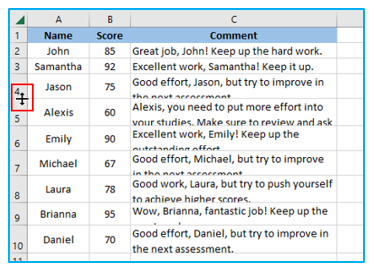
Change Row Height
Step 2: Press the left mouse button while the cursor is on the row header’s bottom edge. To raise the row height, continue to hold down the mouse button and drag it downward (or drag it up to decrease the row height). Once finished, release the mouse key.
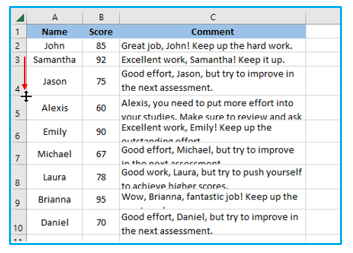
If you simply need to adjust the row height for one or a few rows, this is a nice option because it is simple.
You can repeat this process for other rows. To increase or reduce the height for all the rows, simply use the cursor and drag (for any of the selected rows).
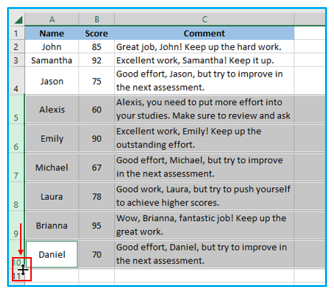
This approach has the issue of not consistently producing the same results each time the row height is altered. For instance, it might not be the same if you modify the row height for one row and then again for another row (it may be close but may not exactly be the same)
Let’s examine further techniques that are more exact and useful for changing the row height of numerous rows at once.
2. Utilizing the Mouse Double-Click Technique to Change the Row Height
This is the quickest and simplest option if you want Excel to automatically modify the row height so that the text fits within the cell correctly.
Let’s say you wish to adjust the third row’s row height in a data set like the one below (so that the entire text is visible in the row).

Using a double-click on the mouse, follow these steps to automatically alter the row height:
Step 1: Set the cursor on the row header’s bottom edge where you wish to modify the height. The cursor will transform to a “+” sign, as you can see.
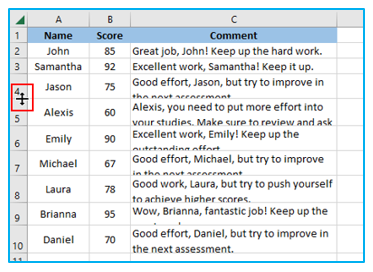
Step 2: Double-click with the cursor on the alphabet’s bottom edge (press the left mouse key in quick succession). Once finished, release the mouse key.
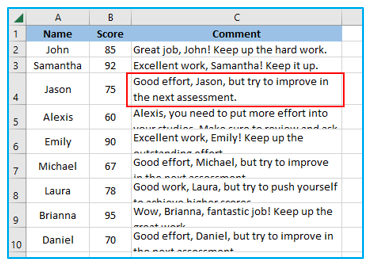
To make sure there is enough room to fit all the text inside the cell, the row height automatically grows or compresses when you double-click the mouse key.
This is also possible for a variety of cells.
For instance, if you have numerous cells, as I have, and you need to set the row height for each cell only, pick the row header for these cells and double-click on each row’s edge.
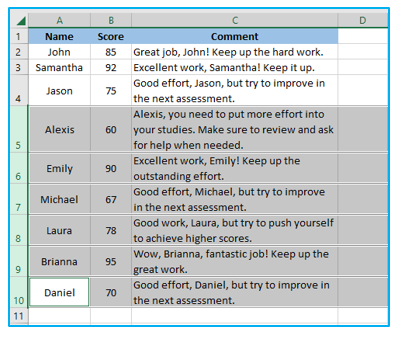
By utilizing the mouse right click you can change the column width and row height alternatively adjust the column width or row height.
3. Setting the Row Height Manually in Worksheet
For a row, you can specify the precise row height you like (or multiple rows).
Let’s imagine you have a data set like the one below and want to make all of the rows in the data set’s row height larger.

The procedures are as follows:
Step 1: By dragging and clicking on the excel row headings, all the rows are selected (or select the row cells in a column for all the rows for which you want to change the height)
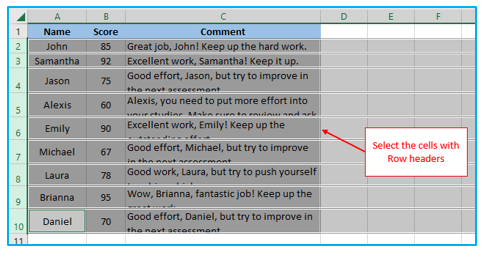
Step 2: On the “Home” tab, click. Choose the “Format” option under the “Cells” group. Select “Row Height…” from the dropdown by clicking it.
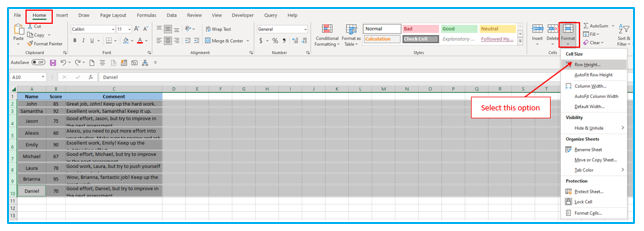
Step 3: Enter the desired height for each of these chosen rows in the Row Height dialog box. In this case, 50 would be my choice. Click on OK.
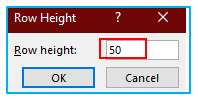
All of the selected rows’ row heights would be changed by the aforementioned steps to 50. (The default row height on my system was 14.4)
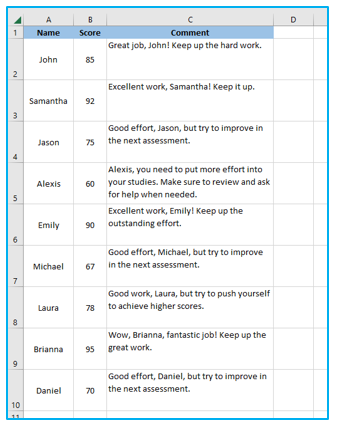
Although you can utilize the mouse double-click technique that was previously discussed, this technique differs in that all of your rows are the same height (which some people find better).
4. Keyboard Shortcut to Change Row Height in Excel
Instead, if you would rather use a keyboard shortcut, use this approach.
The keyboard shortcut shown below will open the row height dialog box, allowing you to manually enter the desired row height value.
ALT + H + O + H (press one after the other)
Let’s imagine you have a data set like the one below and want to make all of the rows in the data set’s row height larger.

The steps to modify the row height with this keyboard shortcut are as follows:
The following steps are a shortcut to specify the row height:
Step 1: By dragging and clicking on the row headings, all the rows are selected (or select the cells in a column for all the rows for which you want to change the height)
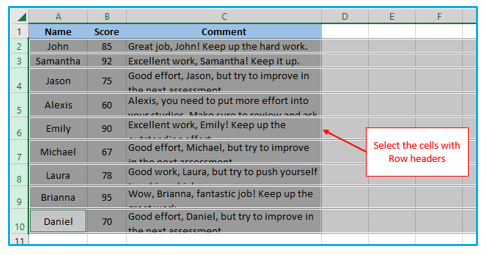
Step 2: Use the shortcut ALT + H + O + H on the keyboard. Enter the desired height for each of these chosen rows in the Row Height dialog box that appears. In this case, 50 would be my choice. Click on OK.
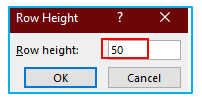
All of the selected rows’ row heights would be changed by the aforementioned steps to 50. (The default row height on my system was 14.4)
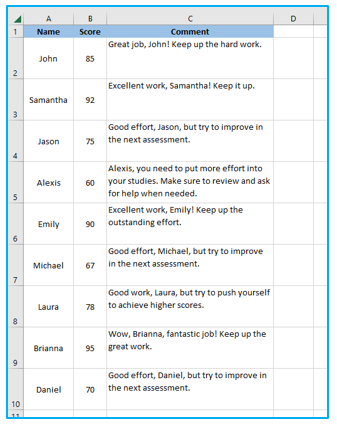
Since you can adjust the row height without getting up from your keyboard, many people favor this technique (if you have a certain height value in mind that you want to apply for all the selected cells).
Although it appears to be a lengthy keyboard shortcut, if you get used to it, it is quicker than the other techniques mentioned above.
5. Autofit Row Height
Most of the techniques shown thus far rely on the user providing the row height (either by clicking and dragging or by entering the value of the row height in the dialog box).
You don’t want to do this manually, though, in many situations.
Sometimes all that is necessary to ensure that the text is seen is to ensure that the row height changes.
Use the autofit option in this situation.
Imagine you have a data set like the one below with more text in each cell, but the extra text is getting cut off because the cell’s height is insufficient.

The procedures for using autofit to raise the row height such that the text fits in it are as follows:
Step 1: Choose the rows you want to automatically fit.
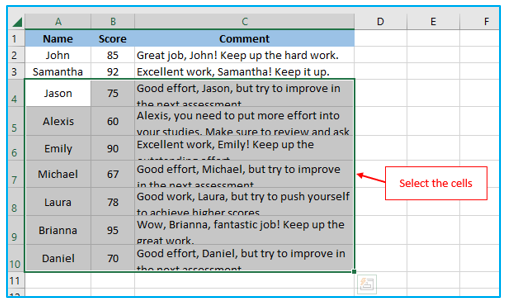
Step 2: On the “Home” tab, click. Choose the “Format” option under the “Cells” group. Select “Autofit Row Height” from the dropdown by clicking it.
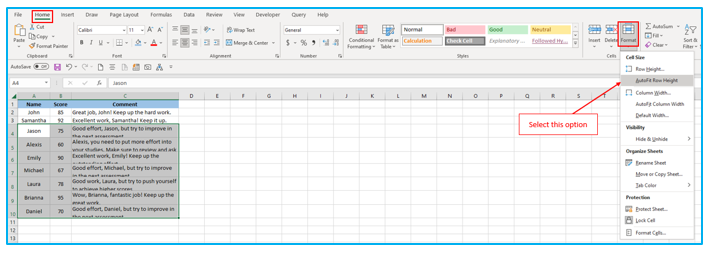
The aforementioned actions would adjust the row height and automatically resize the text so that all of the text in these rows is now visible.
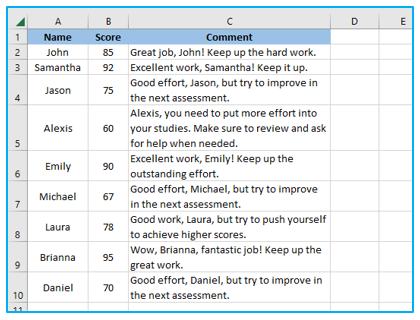
If you alter the column height, the row height will also change automatically to ensure that there are no additional spaces between columns.
6. How to set or change the default row height in excel?
Although it would be fantastic to have the ability to set the default row height, as of the time this article was written, there was no method to do so.
The default row height in the Excel version I’m using right now (Microsoft 365) is 14.4.
I read in one of the articles I found online that if I changed the default font size, the row height would also change.
Even though it just takes a few seconds to modify the row height using any of the methods I’ve shown above in this tutorial, this is too untidy even though it appears to function.
Bottom line In Excel, there is currently no option to set the default row height.
I don’t anticipate Excel will have this capability any time soon, given how simple it is to modify the row height and column width (or ever).
I’ve provided you with 5 simple methods in this guide for fast changing the row height (by using the mouse, a keyboard shortcut, or by using the autofit feature).
The column width can be changed using any of the techniques discussed above.
For ready-to-use Dashboard Templates:
